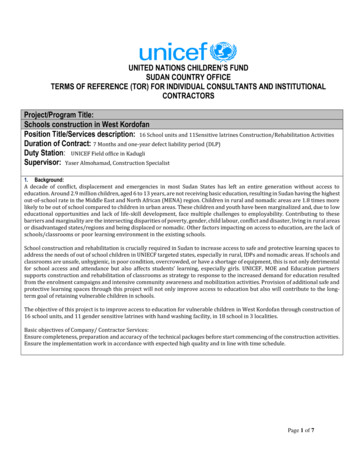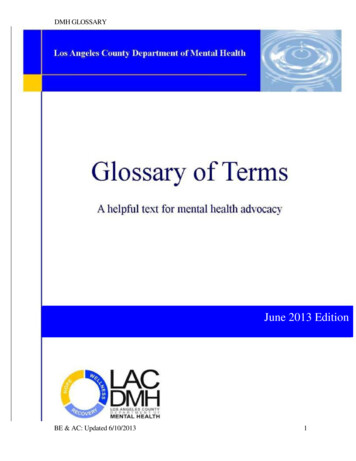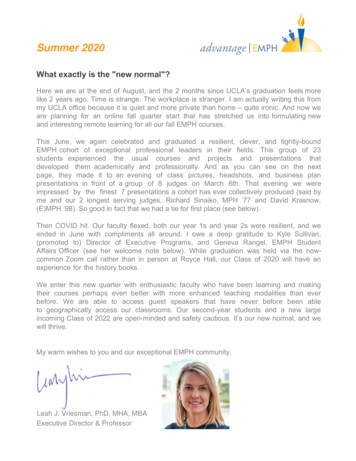
Transcription
UCLAUCLA Previously Published WorksTitleEvaluating eating behavior treatments by FDA m/3s16854gJournalFrontiers in psychology, 4(JAN)ISSN1664-1078AuthorsTomiyama, A JanetAhlstrom, BrittMann, TraciPublication Date2014-01-03DOI10.3389/fpsyg.2013.01009Peer reviewedeScholarship.orgPowered by the California Digital LibraryUniversity of California
PERSPECTIVE ARTICLEpublished: 03 January 2014doi: 10.3389/fpsyg.2013.01009Evaluating eating behavior treatments by FDA standardsA. Janet Tomiyama1 *, Britt Ahlstrom1,2 and Traci Mann 212Department of Psychology, University of California, Los Angeles, Los Angeles, CA, USADepartment of Psychology, University of Minnesota, Minneapolis, MN, USAEdited by:Esther Katharina Papies, UtrechtUniversity, NetherlandsReviewed by:Jacob Burmeister, Bowling GreenState University, USAMichael R. Lowe, Drexel University,USAHubert Preissl, University of Tübingen,Germany*Correspondence:A. Janet Tomiyama, Department ofPsychology, University of California,Los Angeles, 1285 Franz Hall, 502Portola Plaza, Los Angeles, CA90095-1563, USAe-mail: tomiyama@psych.ucla.eduBehavioral treatments for obesity are not evaluated by the same criteria as pharmaceuticaldrugs, even though treatments such as low-calorie dieting are widely prescribed, requirepatients’ time and investment, and may have risks. The Food and Drug Administration (FDA)has a procedure for evaluating drugs, in which drugmakers must answer the followingquestions: (1) Is the treatment safe? (2) How dangerous is the condition the interventionis treating? (3) Is the treatment effective? (4) Is the treatment safe and effective forlarge numbers of people? We argue that using this framework to evaluate behavioralinterventions could help identify unanswered research questions on their efficacy andeffectiveness, and we use the example of low-calorie dieting to illustrate how FDA criteriamight be applied in the context of behavioral medicine.Keywords: FDA, dieting, diets, behavioral treatments, interventions, weight, obesity, eating behaviorINTRODUCTIONObesity rates in America have more than doubled in the last30 years, and currently one third of adults are considered obese,and another third are considered overweight (Flegal et al., 2012).Both the increase in obesity levels and the prevalence of obesityare of great concern to our government, medical community,and the public, and significant efforts to prevent and treat obesity are being made. The National Institutes of Health spent 830 million on obesity research in fiscal year 2011. Unlike manydiseases, obesity is notable in that there is no gold-standard pharmacological intervention. Most treatment approaches to obesityinvolve some form of behavior change, and most involve restrictivedieting.Behavioral interventions, however, are not evaluated according to the same criteria as pharmaceutical drugs. In this article,we argue that examining behavioral interventions using the criteria of the Food and Drug Administration (FDA) is a usefulexercise for identifying unanswered research questions on the efficacy and effectiveness of behavioral treatments. We use dieting,or the restriction of caloric intake for the purpose of weight loss,as our exemplar, and outline how researchers might benefit fromapplying the standard criteria used for evaluating drugs.The goal of governmental agencies like the FDA is to protectpublic health and promote the use of safer and more effectivetreatments. Although behavioral interventions are not regulatedby the FDA, behavior can affect health profoundly. McGinnis andFoege (1993) estimated that 40% of US deaths were preventablethrough changing behavior, and this appeared to still be true adecade later (Mokdad et al., 2004). Behavioral treatments can evenoutperform pharmaceutical treatments, as was the case with theDiabetes Prevention Program (Knowler et al., 2009).We suggest that several factors have conspired to create a situation where behavioral treatments are not considered worthy ofregulatory oversight. First, most behavioral interventions involvewww.frontiersin.orgcommonplace behaviors. In the case of dieting, the behavior isundertaken frequently to improve one’s appearance. Second, thechanges in health outcomes are often slow. Most dieting interventions lead to 1 pound per week of weight loss, whereas, forexample, a dose of epinephrine will immediately cure anaphylaxis. Third, behavioral interventions are not perceived to carrythe same level of risks as pharmaceutical treatments – they arenot ingested, and they are non-invasive. These reasons are certainly understandable, but are fallacious as arguments for whybehavioral treatments do not need to be evaluated as rigorouslyas are pharmaceutical drugs. Commonplace behaviors can bedeadly (e.g., driving a car). Health outcomes that change slowlycan also be deadly (e.g., cancer). Behavioral interventions maycarry fewer risks than pharmaceutical treatments, but they arelikely not without any risks – risks that do not undergo regulatoryoversight before being recommended to patients. Accordingly, inthis article we demonstrate how one might evaluate behavioraltreatments using the Manual of Policies and Procedures (MAPP)created by the FDA’s Center for Drug Evaluation and Research(2010).FDA FRAMEWORKTo obtain FDA approval, five questions must be addressed over thecourse of four phases of trials. Phase 1 comprises two questions:(1) Is the treatment safe? (2) How dangerous is the condition? Thelatter question is necessary because the riskiness of treatmentsmust be balanced by the severity of the problems being treated.The more severe the problem, the more we may be willing to usetreatments that have potentially harmful side effects. Treatmentsthat involve high risk would not be offered for a common cold, butmight be offered for a deadly type of cancer. In Phase 2, the FDAasks: is the treatment effective? In Phase 3, the FDA asks: is thetreatment safe and effective for large numbers of people? Phase 4is a post-approval phase that we will not discuss here.January 2014 Volume 4 Article 1009 1“fpsyg-04-01009” — 2013/12/30 — 16:56 — page 1 — #1
Tomiyama et al.FDA and DietingThe most rigorous form of evaluation study is a randomizedcontrolled trial (RCT), and enough of these types of trials existin eating behavior interventions that we suggest only consideringRCTs when applying FDA criteria to them in the context of efficacy.When looking at evidence from clinical trials, the FDA considersthe type and sample size of those trials. Phase 1 clinical trials havethe smallest sample size and test for the safety of the treatment,and determine whether the treatment has side effects. Phase 2trials primarily use RCTs of a few 100 participants to test howwell the treatment works. Phase 3 trials tend to involve manythousands of people and gather further information about thepopulations in which the treatment is effective. They may alsocompare the treatment’s efficacy against the current gold-standardtreatment.APPLYING FDA CRITERIA TO DIETINGIn the following sections, we use dieting as a test case todescribe how we might apply the FDA criteria to eating behaviorinterventions.PHASE 1: SAFETY OF TREATMENT VERSUS DANGEROUSNESS OFCONDITIONIs dieting safe?Any drug, in order to be approved by the FDA, must be evaluatedfor its safety. All the side effects of the drug must be reported sothat we may ultimately assess whether the benefits of the treatmentoutweigh those risks. Examples of “side effects” in the dieting context might be eating disorder pathology (Stice et al., 2011), bingeeating (Polivy and Herman, 2002; Wadden et al., 2004), malnutrition (French and Jeffery, 1994), smoking, alcohol, and marijuanause (Krahn et al., 2005; Crow et al., 2006; Seo and Jiang, 2009),depression (Wadden et al., 2004), psychological distress (Isomaaet al., 2010), lower self-esteem (Pesa, 1999; Ackard et al., 2002),cognitive deficits (McFarlane et al., 1999), weight cycling (Diazet al., 2005), and stress (Tomiyama et al., 2010).In discussing side effects, several considerations should beaddressed. Were the side effects observed in studies with longitudinal or cross-sectional designs, rather than designs that allowfor causal inference? Some judgment must be made as to howto balance studies documenting the respective side effects countered by studies failing to observe them. The timeframe of studiesvaries widely, and it is unclear whether studies that test for butdo not find evidence of specific side effects have sufficiently longfollow-up periods to observe the risks of dieting. Alternately, andparticularly in the case of experimental laboratory studies thatallow for causal inference but take place within a timeframe ofhours to days, documented side effects may be short-lived and ofminimal concern.How dangerous is the condition?This question seems straightforward, and often is in the case ofpharmaceutical treatments. In the context of behavioral treatments, however, this question becomes more complex, as thereare multiple “conditions” that behavioral treatments are meant toaffect. Even in the case of dieting treatments, where the condition that dieting is meant to treat is almost always overweightand obesity, the answer to this question is unclear. AlthoughFrontiers in Psychology Eating Behaviorthe American Medical Association recently voted to label obesityas a disease, there is substantial evidence that being overweightdoes not increase risk for mortality (Flegal et al., 2013) or disability (Alley and Chang, 2007), and the mortality risks associatedwith obesity appear to have decreased over time (Flegal et al.,2005). Furthermore, the majority of obesity-related deaths occuramong individuals with a body mass index (BMI) 35 and above(Flegal et al., 2013). The research clearly shows that overweightis not consistently associated with disability or mortality andthat many overweight and obese individuals experience few, ifany, adverse health consequences due to their weight. In manystudies, obesity is in fact associated with better outcomes – aphenomenon known as the “obesity paradox” (Clark et al., 2011).These results may indicate that the true problem is with the current system of using BMI categories to characterize excess weight(Kuczmarski and Flegal, 2000). Nevertheless, if overweight andobesity under current BMI categories and guidelines are the “conditions” that the FDA must balance against the risks of dieting, therisks will need to be shown as extremely minimal at BMI rangesbelow 35.Other conditions that dieting interventions are meant to treatinclude hypertension, hypercholesterolemia, or insulin resistance. The evidence that these conditions are dangerous is muchmore defensible (see Tomiyama et al., 2013 for a review). Someindividuals diet to improve their quality of life and reduce disability, rather than to reduce their risk of death or disease.And indeed, Jia and Lubetkin (2010) reported that all classes ofobesity combined contributed to 0.05 quality-adjusted life yearslost; a number that has more than doubled since 1993. However, the FDA does not include quality-adjusted years of lifelost in their consideration for approval, and as we summarizenext, the criterion on which dieting interventions are currentlyevaluated is, in the overwhelming majority of trials, weightchange.PHASES 2 AND 3: EFFICACYWhat does it mean for dieting to work?What to measure. In order to assess whether dieting is an effective treatment for overweight and obesity, we must first decideon appropriate criteria upon which to judge it. The MAPP refersto this criterion as the primary endpoint, and for dieting, thisendpoint is nearly always weight loss. Although we would arguethat improved health rather than weight loss should be the measure of effectiveness, we recognize that weight loss is the currentlyaccepted definition of success. We therefore summarize how FDAPhase 2 criteria would be applied when evaluating the effectivenessof dieting in reducing weight.The necessary amount of weight loss for a diet to be consideredeffective is somewhat arbitrary, and it has changed dramaticallysince researchers first started routinely studied dieting. The original standard for success required dieters to reach a “normal”weight as defined by the Metropolitan Life Insurance Company(1942). For example, an average height woman (5 5 ) of mediumbody frame was expected to weigh about 134 pounds (Metropolitan Life Insurance Company, 1942), so a 200-pound womanof average height would need to lose 66 pounds to be considered a successful dieter. This standard was rarely achievedJanuary 2014 Volume 4 Article 1009 2“fpsyg-04-01009” — 2013/12/30 — 16:56 — page 2 — #2
Tomiyama et al.FDA and Dieting(Stunkard and McLaren-Hume, 1959), and over the next 50 yearsthe standard changed from losing 20% of one’s starting weight,to 10%, and to just 5% of one’s starting weight (Institute ofMedicine, 1995, p. 5). Now, an average height woman weighing 200 pounds needs to lose just 10 pounds to be considereda successful dieter. The use of this criterion as the primaryendpoint would need to be justified to the FDA in terms ofits validity and whether it provides “a reasonable assessmentof clinical benefit” (Center for Drug Evaluation and Research,2010).When to measure it. In addition to selecting an appropriate endpoint, researchers also need to decide when that endpoint shouldbe assessed. The current standard set by the Institute of Medicineis that individuals need to maintain a 5% weight loss for a year.The year, however, is counted as beginning when the diet begins,rather than beginning when that target weight is reached. Thisconvention is likely used to make it easier to evaluate and comparediets, because individuals reach target weights at different timepoints. Regardless, the 1 year weight loss maintenance standard isnot actually a measure of whether one maintained weight loss fora full year, but rather whether an individual is at the target weight1 year after beginning the diet. The MAPP requires a discussion ofthe “adequacy of duration” of the clinical trials, and it is not clearif this maintenance period would be considered adequate.The issue of when to judge the success of a treatment is particularly complex when it comes to dieting. Dieters tend to takeoff weight quickly at first, then more slowly, followed by weightregain over several more years (Garner and Wooley, 1991). Theeffectiveness of the diet will look quite different if it is measuredat the end of the early stage when weight has come off, or later, asit is regained.Pharmaceutical treatments differ on whether they are evaluatedduring active treatment or at some time point after treatment ends.An antibiotic would not be considered effective if the bacteriawere only eradicated during the time individuals were taking themedication, and then came back again after the treatment ended.Similarly, chemotherapy for cancer would not be judged effectiveif tumors reappeared immediately at the end of treatment. Onthe other hand, medications such as anti-depressants and painmedications are only expected to be effective while individuals aretaking them.It can be argued that diets are only expected to “work” whileindividuals are actively engaging in them. If so, then the shortterm effectiveness would be considered the appropriate measure.Proponents of this viewpoint argue that diets would work if individuals would just stay on them, and the short-term effectivenessis the only measure taken while individuals are still restricting theirintake. It is not yet known, however, if diets stop leading to weightloss because individuals stop restricting their eating, or if individuals stop restricting their eating because the diets stopped leadingto weight loss (or a combination of these). There is evidence thatdieters’ weight loss tends to level off during diets even while theyadhere to the diet (Tataranni and Ravussin, 2004), and that individuals who successfully lose weight at a certain calorie level cannotnecessarily maintain the new weight at that calorie level (Leibel andHirsch, 1984). If this is the case, then dieters should be informedwww.frontiersin.orgthat they can only expect their diet to work for a somewhat brieflength of time. This is not a unique circumstance. For example, extended use of medications such as alprazolam (Xanax) anddiazepam (Valium) can result in medication tolerance (i.e., requiring higher doses to achieve the same effect; Ellinwood et al., 1985),and these anxiety medications are usually explicitly recommendedfor short-term use. Another consideration is whether the use ofdieting treatment might make subsequent dieting treatments lesseffective (Tataranni and Ravussin, 2004), just as cochlear implantscan render other treatments for hearing loss impossible (Lenarzet al., 2013).In terms of evaluating the effectiveness of diets, we are proponents of the viewpoint that one cannot consider a diet successfulif individuals rapidly regain the weight they lost. According to thisviewpoint, the longer-term effectiveness is the appropriate measure. Obesity-related illnesses tend to be chronic diseases, suchas cardiovascular disease and diabetes, and to be successful, webelieve their treatments must lead to long-term benefits.Study design. In addition to describing the outcomes of the clinicaltrials, the MAPP also requires a discussion of aspects of studydesign that might limit the conclusions that can be drawn. Onearea of focus is whether the validity of the study is threatenedby “subject disposition,” which includes both the rate of subjectexclusion from entry into the study and the rate of drop-outs.Generalizability can be threatened when the exclusion criteriafor a study are so extensive that the sample is not representativeof typical users of that drug. In dieting studies, participants canbe excluded if their BMI is above a certain cut-off, they have apresent or past diagnosis of heart disease, angina, or other physical or psychological illnesses, or if their levels of certain macro-ormicro-nutrients (e.g., glucose, sodium) are too high (reviewed inTomiyama et al., 2013). These exclusions limit the generalizabilityof the findings to just healthier dieters. Of more concern in termsof generalizability, several studies exclude subjects that researchersfelt would not be able to adhere to the study requirements. Thesemultiple enrollment steps, called “run-in periods,” are often recommended in clinical trials and are intentionally stringent in orderto isolate a participant pool that will remain in the study until theend (Friedman et al., 2010). This may result in samples of participants who are more motivated and more successful at alteringtheir behavior than the average dieter. In one study, for example,18.8% of the potential participants were excluded before the studybegan for failing to control their diabetes with their diet for theprevious 6 weeks (Hanefeld et al., 1991).Generalizability can also be threatened due to study attrition(for a more detailed analysis of this problem, see Mann et al.,2007). Many reasons for loss to follow-up are seemingly random (e.g., the subject moves and can no longer be located by theresearchers). Others could be problematic (e.g., excluding subjectsfrom analyses because of serious illness or death). To the extentthat these drop-outs occur in differing proportions among the dietand control conditions, internal validity may also be threatened.Phase 3: the issue of adherenceA starting point to determine the patient populations for whomdieting should be approved is examining the exclusion criteriaJanuary 2014 Volume 4 Article 1009 3“fpsyg-04-01009” — 2013/12/30 — 16:56 — page 3 — #3
Tomiyama et al.FDA and Dietingfor the original trials. Adherence to dieting is the most consistentpredictor of weight loss and changes in health outcomes (Pagotoand Appelhans, 2013), and as noted above, non-adherent individuals are often excluded from trials. Despite the importanceof adherence, dieting interventions are not evaluated based onwhether participants are able to adhere to the regimen. Adherence is often raised as the reason that a given trial succeededor failed, but that is a separate issue from using adherence as acriterion upon which to judge dieting. The FDA addresses theissue of adherence in section 208.1 of its code of regulations, andstates that special labeling should be used in cases when “patientadherence to directions for use is crucial to the drug’s effectiveness.” Under an FDA framework, dieting might be prescribedalong with label information about the importance of adherence for the treatment’s effectiveness, including information thateven with 100% adherence, weight loss may plateau, as notedabove.DISCUSSIONIn this Perspective article, we considered whether viewing behavioral interventions through the lens of FDA regulations is worthwhile. Using the FDA’s framework illuminated areas for futureresearch that may not have otherwise been considered. For example, in evaluating dieting, current researchers do not consider theintervention balanced against the severity of the condition it isdesigned to treat. Dieting occupies a significant portion of anindividual’s resources, and it may also prevent individuals fromattempting other forms of treatment. This analysis has also uncovered that more research is needed on efficacy in relation to whetherweight is lost but then regained; the length of treatment that isrequired for a given level of efficacy; how consistently and withwhat level of adherence the dieting treatment must be “applied”to reach efficacy; and whether adherence to the treatment is arealistic expectation. A final strength of applying FDA criteria todieting is that it can serve to refocus the goals of dieting trialssquarely on improving health rather than reducing weight. Incorporating this framework into traditional methods of evaluationmay lead to new insights in the search for effective behavioraltreatments.ACKNOWLEDGMENTSThe authors gratefully acknowledge Eli Finkel, Andrew Ward, andHallie Espel for their comments on a draft of this manuscript.The authors are also grateful to Angela C. Incollingo Belsky forher help in preparing a version of the manuscript. This work waspartially supported by National Institutes of Health grant R01HL88887 to Traci Mann. The content is solely the responsibilityof the authors and does not necessarily represent the official viewsof the National Heart Blood and Lung Institute or the NationalInstitutes of Health.REFERENCESAckard, D. M., Croll, J. K., and Kearney-Cooke, A. (2002). Dieting frequency amongcollege females: association with disordered eating, body image, and relatedpsychological problems. J. Psychosom. Res. 52, 129–136. doi: 10.1016/S00223999(01)00269-0Alley, D. E., and Chang, V. W. (2007). The changing relationship of obesity anddisability, 1988-2004. JAMA 298, 2020–2027. doi: 10.1001/jama.298.17.2020Frontiers in Psychology Eating BehaviorCenter for Drug Evaluation and Research. (2010). Good Review Practice: ClinicalReview Template (MAPP 6010.3, Rev. 1). Silver Spring, MD; Food and DrugAdministration.Clark, A. L., Fonarow, G. C., and Horwich, T. B. (2011). Waist circumference, bodymass index, and survival in systolic heart failure: the obesity paradox revisited. J.Card. Fail. 17, 374–80. doi: 10.1016/j.cardfail.2011.01.009Crow, S., Eisenberg, M. E., Story, M., and Neumark-Sztainer, D. (2006). Psychosocial and behavioral correlates of dieting among overweight and non-overweightadolescents. J. Adolesc. Health 38, 569–574. doi: 10.1016/j.jadohealth.2005.05.019Diaz, V. A., Mainous III, A. G., and Everett, C. J. (2005). The association betweenweight fluctuation and mortality: results from a population-based cohort study.J. Community Health 30, 153–165. doi: 10.1007/s10900-004-1955-1Ellinwood, E. H., Heatherly, D. G., Nikaido, A. M., Bjornsson, T. D., andKilts, C. (1985). Comparative pharmacokinetics and pharmacodynamics oflorazepam, alprazolam and diazepam. Psychopharmacology 86, 392–399. doi:10.1007/BF00427897Flegal, K. M., Carroll, M. D., Kit, B. K., and Ogden, C. L. (2012). Prevalence of obesityand trends in the distribution of body mass index among US adults, 1999-2010.JAMA 307, 491–497. doi: 10.1001/jama.2012.39Flegal, K. M., Graubard, B. I., Williamson, D. F., and Gail, M. H. (2005). Excess deathsassociated with underweight, overweight, and obesity. JAMA 293, 1861–1867. doi:10.1001/jama.293.15.1861Flegal, K. M., Kit, B. K., Orpana, H., and Graubard, G. I. (2013). Association ofall-cause mortality with overweight and obesity using standard Body Mass Indexcategories. JAMA 309, 71–82. doi: 10.1001/jama.2012.113905French, S. A., and Jeffery, R. W. (1994). Consequences of dieting to lose weight:Effects on physical and mental health. Health Psychol. 13, 195–212. doi:10.1037/0278-6133.13.3.195Friedman, L. M., Furberg, C. D., and DeMets, D. L. (2010). Fundamentals of ClinicalTrials, 4th Edn. New York: Springer. doi: 10.1007/978-1-4419-1586-3Garner, D. M., and Wooley, S. C. (1991). Confronting the failure of behavioral anddietary treatments for obesity. Clin. Psychol. Rev. 11, 729–780. doi: 10.1016/02727358(91)90128-HHanefeld, M., Fischer, S., Schmechel, H., Rothe, G., Schulze, J., Dude,H., et al. (1991). Diabetes Intervention Study. Multi-intervention trial innewly diagnosed NIDDM. Diabetes Care 14, 308–317. doi: 10.2337/diacare.14.4.308Institute of Medicine. (1995). “The nature and problem of obesity,” in Weighing theOptions: Criteria for Evaluating Weight-Management Programs, ed. P. R. Thomas(Washington, DC: National Academy Press), 55–58.Isomaa, R., Isomaa, A. L., Marttunen, M., Kaltiala-Heino, R., and Bjorkqvist, K.(2010). Psychological distress and risk for eating disorders in subgroups of dieters.Eur. Eat. Disord. Rev. 18, 296–303. doi: 10.1002/erv.1004Jia, H., and Lubetkin, E. I. (2010). Obesity-related quality-adjusted life yearslost in the U.S. from 1993 to 2008. Am. J. Prev. Med. 39, 220–227. doi:10.1016/j.amepre.2010.03.026Knowler, W. C., Fowler, S. E., Hamman, R. F., Christophi, C. A., Hoffman, H.J., Brenneman, A. T., et al. (2009). 10-year follow-up of diabetes incidence andweight loss in the Diabetes Prevention Program Outcomes Study. Lancet 374,1677–1686. doi: 10.1016/S0140-6736(09)61457-4Krahn, D. D., Kurth, C. L., Gomberg, E., and Drewnowski, A. (2005). Pathologicaldieting and alcohol use in college women–a continuum of behaviors. Eat. Behav.6, 43–52. doi: 10.1016/j.eatbeh.2004.08.004Kuczmarski, R. J., and Flegal, K. M. (2000). Criteria for definition of overweight intransition: background and recommendations for the United States. Am. J. Clin.Nutr. 72, 1074–1081.Leibel, R. L., and Hirsch, J. (1984). Diminished energy requirements in reducedobese patients. Metabolism 33, 164–70. doi: 10.1016/0026-0495(84)90130-6Lenarz, T., Pau, H.-W., and Paasche, G. (2013). Cochlear implants. Curr. Pharm.Biotechnol. 14, 112–23.Mann, T., Tomiyama, A. J., Westling, E., Lew, A. M., Samuels, B., and Chatman, J.(2007). Medicare’s search for effective obesity treatments: diets are not the answer.Am. Psychol. 62, 220–233. doi: 10.1037/0003-066X.62.3.220McFarlane, T., Polivy, J., and McCabe, R. E. (1999). Help, not harm: psychologicalfoundation for a nondieting approach toward health. J. Soc. Issues 55, 261–276.doi: 10.1111/0022-4537.00115McGinnis, J. M., and Foege, W. H. (1993). Actual causes of death in the UnitedStates. JAMA 270, 2207–2212. doi: 10.1001/jama.1993.03510180077038January 2014 Volume 4 Article 1009 4“fpsyg-04-01009” — 2013/12/30 — 16:56 — page 4 — #4
Tomiyama et al.FDA and DietingMetropolitan Life Insurance Company (1942). Ideal weights for women. Stat. Bull.23, 6–8.Mokdad, A. H., Marks, J. S., Stroup, D. F., and Gerberding, J. L. (2004).Actual causes of death in the United States, 2000. JAMA 291, 1238–1245. doi:10.1001/jama.291.10.1238Pagoto, S. L., and Appelhans, B. M. (2013). A call for an end to the diet debates.JAMA 310, 687–688. doi: 10.1001/jama.2013.8601Pesa, J. (1999). Psychosocial factors associated with dieting behaviors amongfemale adolescents. J. Sch. Health 69, 196–201. doi: 10.1111/j.1746-1561.1999.tb06385.xPolivy, J., and Herman, C. P. (2002). Causes of eating disorders. Annu. Rev. Psychol.53, 187–213. doi: 10.1146/annurev.psych.53.100901.135103Seo, D. C., and Jiang, N. (2009). Associations between smoking and extreme dietingamong adolescents. J. Youth Adolesc. 38, 1364–1373. doi: 10.1007/s10964-0099421-0Stice, E., Marti, C. N., and Durant, S. (2011). Risk factors for onsetof eating disorders: evidence of multiple risk pathways from an 8-yearprospective study. Behav. Res. Ther. 49, 622–627. doi: 10.1016/j.brat.2011.06.009Stunkard, A. J., and McLaren-Hume, M. (1959). The results of treatment for obesity: a review of the literature and report of a series.AMA Arch. Intern. Med. 103, 79–85. doi: 10.1001/archinte.1959.00270010085011Tataranni, P. A., and Ravussin, E. (2004). “Energy metabolism and obesity,” inHandbook of Obesity Treatment, eds T. A. Wadden and A. J. Stunkard (New York:Guilford Press), 42–72.www.frontiersin.orgTomiyama, A. J., Ahlstrom, B., and Mann, T. (2013). Long-term effects of dieting:is weight loss related to health? Soc. Personal. Psychol. Compass 7, 861–877. doi:10.1111/spc3.12076Tomiyama, A. J., Mann, T., Vinas, D., Hunger, J. M., Dejager, J., and Taylor, S. E.(2010). Low calorie dieting increases cortisol. Psychosom. Med. 72, 357–364. doi:10.1097/PSY.0b013e3181d9523cWadden, T. A., Foster, G. D., Sarwer, D. B., Anderson, D. A., Gladis, M., Sanderson,R. S., et al. (2004). Dieting and the development of eating disorders in obesewomen: results of a randomized controlled trial. Am. J. Clin. Nutr. 80, 560–568.Conflict of Interest Statement: The authors declare that the research was conductedin the absence of any commercial or financial relationships that could be construedas a potential conflict of intere
Psychology, University of California, Los Angeles, 1285 Franz Hall, 502 Portola Plaza, Los Angeles, CA 90095-1563, USA e-mail: tomiyama@psych.ucla.edu Behavioral treatments for obesity are not evaluated by the same criteria as pharmaceutical drugs, even though treatments such as low-calorie dieting are widely prescribed, require










